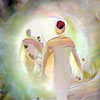Past Life Patterns ~ Part II
 by Rosemary Ellen Guiley
by Rosemary Ellen Guiley
Sex Change
Individuals who go through past-life regression often are surprised to find themselves as the opposite sex. Not all, but some, men have a much more difficult time accepting female lives than women do male lives—a reflection of a pervasive male view of women as inferior. In fact, in some cultures which believe in reincarnation, such as the Druse of Lebanon, men refuse to believe it is possible to reincarnate as women; it is simply unacceptable. In other cultures, such as Burma, it is considered punishment for a man to be reborn as a woman.
Ian Stevenson considered the incidence of sex change as the most important variation in features of reincarnation cases in different cultures. His research showed that the incidence of reported sex change does seem to be influenced by cultural attitudes. Stevenson found no reported case of a male being reborn as a female in Lebanon or Turkey, or among the Tlingit Indians of southeastern Alaska, and the Haida, Tsimsyan and Gitskan Indians of British Columbia. Among cultures that do have reported sex change cases, females who remember past lives as males occur three times as often as males who remember female lives.
The incidence of sex change ranges from a low of 3 percent of all reported cases in India to a high of 50 percent among the Kutchin (Athabaskan) Indians of the Canadian Northwest Territories. Sex change accounts for 15 percent of all reported non-tribal cases in the United States, 9 percent in Sri Lanka, 13 percent in Thailand and 28 percent in Burma.
If a man believes that it is either highly undesirable, or impossible, to be reborn as a woman, does this mean that he doesn’t reincarnate as a woman, or does he merely suppress the memory of female lives? Stevenson said that both answers may be correct. It is certainly likely for undesirable memories to be repressed in order to conform to culture. In addition, Stevenson said, reincarnation beliefs governing sex change might be strong enough to act like post-hypnotic suggestions after death, thus avoiding reincarnation as the opposite sex.
Cayce’s Soul Groups
According to Edgar Cayce, souls have reincarnated throughout history more or less in groups in accordance with their alignments to religions, races, cultures, nations, etc. The largest group comprises the planet itself, for earth is not the only place in the cosmos to live. Soul groups are fluid, their ranks constantly shifting as individual souls change course. Generally, however, the groups come and go in earth history in cycles.
In the thousands of Cayce readings, two major soul groups were identified: Group 1 includes souls who lived in early Atlantis, early ancient Egypt, Persia during the time of Croesus I and Croesus II, Palestine, the Crusades, and colonial America. Group 2 includes souls who lived in late Atlantis, late ancient Egypt, early Greece, Rome during the time of Christ, France during the time of Louis XIV, XV and XVI, and the American Civil War.
The souls who lived during the times in these two groups also most likely had other lives; these periods were ones of great importance in the course of human events and evolution. In their reincarnations, soul groups are subject to karma and planetary influences. A particular group may not desire to collectively reincarnate, for example, but be required to do so for the purposes of balancing karma. Some members of soul groups may be present in a particular cycle in spirit form, as guides, rather than in the flesh, and still have an influence upon earthly affairs.
Emerging Soul Groups
Cayce died on January 3, 1945, shortly before the end of World War II, another great period of world trauma and change. As linear time continues, other watershed periods will undoubtedly mark new soul groups or cycles of groups. Three such groups have emerged: World War II; Vietnam War; and Native American Indians.
World War II. Cases of the reincarnation of souls who died during World War II have been reported; Cayce expressed concern for children killed in the war who reincarnated too quickly and made poor choices for families. The soul group of World War II is complex, for it is interwoven with the ethnic karma of the Jews, which has extended over 3,800 years of history.
Rabbi Yonassan Gershom has collected data in an information study that has yielded interesting information about Jews who died in World War II. According to Gershom, the majority of Holocaust victims in his survey were born between 1946 and 1953. Most of them are not Jewish; those who are typically marginal in their faith, perhaps, he said, because World War II marked their first experience as a Jew. About two-thirds have light hair and blue or hazel eyes. Experiences reported to him include feelings of familiarity and affinity with the Jewish faith, and religious rituals and traditions not generally known outside the Jewish community; familiarity with the Hebrew language, and deja vu or strange experiences upon visiting the sites of concentration camps. One woman who visited a camp felt as though she were walking through mud, even though the paths had, since the war, been covered with gravel. She recognized the building where she knew she had died, and saw her death. At the end of the tour, her feet and socks were muddy, though her shoes were dry.
Others have reported terrifying nightmares of being killed, and phobias of policemen, barbed wire, doctors and uniforms. Two persons reported asthma attacks brought on by Jewish rituals, reminiscent, Gershom said, of choking to death in a gas chamber.
Some Hassidim believe that Hitler was a reincarnation of Amalek, grandson of the evil Esau, who in the Bible came to represent those who prey on the weak. Exodus 17:16 says that “YH’VH [Yahweh] will be at war with Amalek throughout the ages.” This may be taken as a literal reference to the reincarnation of Amalek, or, as Gershom prefers, the indication that God will always fight the oppressor.
Gershom said the Holocaust served as a warning that human rights were in danger, and that it has entered the collective unconscious as an archetype as “an eternal warning about the misuse of our technology.”
The Vietnam War. The Vietnam War divided America into bitter factions, and left shattered families and veterans to contemplate the horrors of killing. Unlike World War II and Word War I, there were no black-and-white issues to grasp as to which side was right and why. A popular Age of New Consciousness theory holds the protesters of the Vietnam War were the reincarnated dead of World War II, some even from World War I, who came back angry about the senselessness of war. As the dead of Vietnam return, they, too, are likely to be regretful, angry or outraged over war.
Native Americans. The Native Americans were made strangers in their own land by the founders and pioneers of this nation. Their way of life was termed savage and held in contempt by the more “civilized” folk who proceeded to pollute and destroy the environment. The New Age has rediscovered that the Native Americans’ ideas about life, spirit, healing and living in harmony with nature are worthy of consideration.
If cultural attitudes have the power to suppress certain past-life memories, as with sex change, they also have the power to release them. Therefore, it is not surprising, in light of the shift in attitudes toward the Indian, that Indian past lives should be on the increase. In addition, I believe that some Indian souls have reincarnated in the race of their oppressors as a teaching tool, to help bring individuals back into touch with Indian culture and stimulate interests that are then pursued long after the regression.
Sutphen’s 25,000
Teotihuacan, in central Mexico, is the site of ruins of an ancient city of once grand splendor. A religious, cultural, economic and political center, its population may have reached a peak of 200,000. It was twelve square miles in size, larger than the area contained within the walls of Imperial Rome under the Caesars, a contemporary civilization. By the time the Aztecs arrived in 1325, it was long deserted and in ruins. The Aztecs named the place “Teotihuacan,” which means “the place where men become gods.”
In 1974, Dick Sutphen and his wife, Tara, visited Teotihuacan and walked among the ruins, including the “Street of the Dead,” mounds in which the Aztecs believed were buried the gods. Sutphen felt a sense of deja vu. He experienced a dream in which he was in ancient Teotihuacan. Thousands of persons filled the street and night. Elegantly robed men lined the steps of the Pyramid of the Moon, atop which was lit a huge fire. In the dream, he was instructed to “get the books together.” He didn’t have the foggiest idea what that meant.
Through a channeler friend, he found out that he was part of a group of persons who had lived at the same time in Teotihuacan, and who had made a pact to reincarnate every 700 years to present the spiritual knowledge that they had possessed at that time. Sutphen was fulfilling that past life pledge by writing books.
Later in 1974, Sutphen had a psychic vision that repeated itself over the years. He was a man dressed in a white tunic with gold braid ribbing, holding a crystal rod and standing on top of the Pyramid of the Sun with fifteen to twenty others. Thousands filled the Street of the Dead. He was projecting his will through the rod, which glowed blue-white, to control masses of people trying to climb the pyramid.
In 1987, Sutphen was awakened in the middle of the night by an inner voice which instructed him it was time for important communications. The voice told him he was one of 25,000 persons who had lived 1,400 years ago in Teotihuacan, and he was to assist others of this group who had reincarnated to awaken to this awareness.
According to information revealed in regressions and psychic consultations, the pact was made in 581 A.D. during a time of political upheaval. Sutphen and Tara were part of a secret religious group of sixteen, who in turn were publicly part of a larger religious council. In a change of political power, the new rulers, a hierarchy of priests, misused their powers and blamed the results on the inner circle, who then disguised their teachings by painting over murals on the walls of the Pyramid of the Sun. The inner circle finally was forced into hiding.
In an effort to make a last, public stand, they summoned the population to the Pyramid of the Sun to hear an announcement. One of every eight persons—25,000 people—appeared, and took the pledge to return every 700 years together. The meeting was scuttled when soldiers arrived and arrested the inner circle and other protesters. The scapegoats were buried alive in pits.
Historically, Teotihuacan declined after the late sixth century, and was eventually sacked and partially destroyed.
Sutphen proceeded to search for the 25,000 in his regression seminars. According to their mission, the 25,000 are to once again spread enlightened ideas around the world, so that the fate which befell Teotihuacan will not happen again.
Proving Past Lives
Most people who see their past lives, especially during a light hypnotic trance, wonder if they are “real” or their imagination, even if it “feels true.” There is little way of proving it. As seen in Wambach’s findings, most past lives are those of the ordinary masses, for whom few, if any records exist. Through research one can substantiate historical details of the period, but seldom can one find proof that a certain individual lived. Few regressions provide full names, let alone sufficient biographical information to track down an identity.
In the area of research of spontaneous recall among children, numerous solved cases in which a child names his previous personality, identifies his former family members, and discloses personal information known only to the dead or his immediate family and friends, would appear to be proof of reincarnation. Scientists take a more cautious view although such cases are evidence in support of reincarnation.
For a hypnotic regression, one must largely rely upon intuition in judging reincarnation memories. Most persons feel that if they were to fabricate a past life about themselves, they would have conjured up lives of glamour, not the usual mundane ones they encountered. It is common for individuals to receive additional past-life information intuitively, long after a regression session.
Alice T., who uncovered more than thirty of her own past lives, observed, “I believe that we have nonphysical beings around us who care about our spiritual development. In a session, I try to strengthen the communication between the client and his or her guides. Sometimes these beings appear in the regression in human or spirit form, or as lights or colors. They help provide answers. Past-life information is surprisingly accessible.”
Sandee Mac believes people do tap into real memories, but she leaves the ultimate decision up to her clients. “I suggest that they trust what comes into their mind, but not get caught up in whether or not they are seeing a ‘real’ past life. The important thing is that they are being given information they need in order to work through something in their present life.”
Psychics also are asked by clients how to judge the information given them. “Why can’t you just trust your feelings?” said Laurie McQuary. “With imagination, you have thousands of scenarios to choose from. When one strong feeling comes through, if you really explore it, you’re going to see it exactly as the way it was and not how you wish it were. Before you start rationalizing whether it’s imagination or not, you’ve got to decide whether you believe in reincarnation. If you do, you don’t think about it being imagination. You trust that it’s the truth.”
Excerpt from Soul Journeys
Posted in Other Topics, Past Life Therapy, Reincarnationwith comments disabled.





